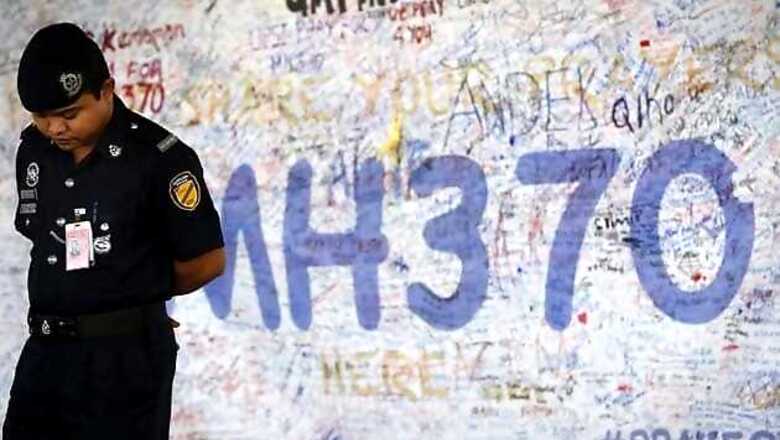
views
Sydney: Australian researchers on Wednesday said they have detected a low-frequency underwater noise off India's southern tip at about the time MH370 mysteriously disappeared, as a British woman sailing from Kochi to Phuket in March claimed that she may have seen the plane on fire.
The researchers detected the mysterious noise, possibly that of an ocean impact, recorded by two undersea receivers in the Indian Ocean about the time the Malaysia Airlines plane ceased satellite transmissions and vanished on March 8 with 239 people on board. The researchers released an audio recording of the underwater sound that they say could possibly be related to the final moments of the missing Boeing 777.
"It's not even really a thump sort of a sound it's more of a dull oomph," Alec Duncan, a senior marine science research fellow at Curtin University near Perth, who has led the research, told The New York Times.
The general vicinity from which the noise emanated is a large area of the central Indian Ocean off the southern tip of India and about 3,000 miles northwest of Australia. But that is not consistent with calculations of an arc of possible locations in the southeastern Indian Ocean where the plane might have run out of fuel.
Those calculations were from Inmarsat, the global satellite communications company. Scientists have struggled to figure out the origin of the noise. "If you ask me what's the probability this is related to the flight, without the satellite data it's 25 or 30 per cent, but that's certainly worth taking a very close look at," Duncan said.
Adding to the uncertainty surrounding the plane's possible final location, a British woman sailing with her husband across the Indian Ocean from Kerala's port city of Kochi to Phuket in Thailand has claimed she may have seen the plane on fire. Katherine Tee, 41, reported on Sunday to the Joint Agency Coordination Centre (JACC) that is leading the MH370 search that she was on night-watch on the couple's 40-feet boat when flight MH370 vanished.
The couple have since re-checked their sailing logs and believe they were near one of the projected flight paths for the aircraft, now missing for nearly three months. Tee, who was at sea for 13 months, said she did not report the sighting at the time because of marital issues and because she feared being mistaken.
"I saw something that looked like a plane on fire. Then I thought I must be mad. It caught my attention because I had never seen a plane with orange lights before so I wondered what they were," she told the Phuket Gazette. Media reports said Australian authorities were looking at Tee's claim.
"It looked longer than planes usually do. There was what appeared to be black smoke behind it," Tee said. "I looked back through our GPS logs...what we saw was consistent with the confirmed contact which the authorities had from MH370," she said. Tee said she saw other planes nearby and thought they would have reported the burning plane.
The search for the missing Malaysia Airlines flight continues to focus along an arc hundreds of kilometers long, the area where investigators believe the Boeing 777 ran out of fuel, about 1,000 miles off the coast of Western Australia. Duncan says his team has calculated an "uncertainty box" for the signal's origin.
It's area that stretches some 4,000 kilometres in length from southeast to northwest across the Indian Ocean, and spans some 200 to 300 kilometres in width at its widest point. The center of the long, narrow box is south of the tip of India, as shown in a map released on Wednesday.
Martin Dolan, the chief commissioner with the Australian Transport Safety Bureau (ATSB), has said an international team of experts continue to review the analysis of Inmarsat satellite data and aircraft performance. Dolan told CNN that he remains confident the final resting place of MH370 is somewhere along that arc, the so-called "partial handshake" with the satellite.
"We've seen all the data. We've seen all the calculations. We are reviewing the calculations and are also developing our own model to cross check and verify that information," Dolan said. The massive Indian Ocean search for the Malaysia Airlines plane, which disappeared on March 8 carrying 239 people including five Indians, has so far failed to find any sign of the Boeing 777.

















Comments
0 comment